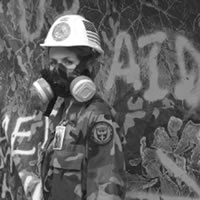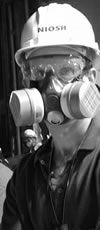Protecting
Workers at the World Trade Center Site
Response from the National Institute for Occupational Safety and Health
| The National Institute for Occupational
Safety and Health (NIOSH) is the federal agency responsible for
conducting research and making recommendations for the prevention
of work-related disease and injury. NIOSH is part of the Centers
for Disease Control and Prevention (CDC). |
The terrorist attacks of September 11, 2001 exposed
rescue and recovery workers to unprecedented levels of risk for job-related
injury, illness, and death. The National Institute for Occupational
Safety and Health (NIOSH), a part of the U.S. Centers for Disease
Control and Prevention (CDC), responded swiftly to address workers'
needs in the aftermath of the attacks. NIOSH quickly sent to Ground
Zero dozens of staff who applied their technical expertise to help
meet immediate worker protection needs. Also, by helping workers and
supervisors build their own safety and health capacity, NIOSH was
able to enhance safety at the sprawling site. In the aftermath, NIOSH
is working with its partners to address concerns about potential long-term
effects on workers' health and to help protect workers in the event
of future emergencies. A summary of NIOSH's assistance follows.
NIOSH Responded to Workers' Immediate Needs:
 Assessed
individual jobs and work locations to identify potential hazards,
including risk of eye injuries from blowing debris and potential
exposures to silica dust, asbestos, and other hazardous materials. Assessed
individual jobs and work locations to identify potential hazards,
including risk of eye injuries from blowing debris and potential
exposures to silica dust, asbestos, and other hazardous materials.
- Helped site managers select appropriate equipment
for sampling, use it properly, and institute procedures for analyzing
samples quickly.
- Helped managers and workers select appropriate
personal protective equipment and coordinated the deployment of
respirators to rescue and recovery workers.
- Developed cost-effective procedures for cleaning
and sanitizing respirators on-site.
- Worked with medical assistance teams to ensure
they were prepared to meet specific emergencies on-site and to help
them develop procedures for follow-up evaluations of worker injuries.
NIOSH Helped Build Safety and Health Capacity:
-
Developed and disseminated written guidelines
to help supervisors integrate worker safety and health into site
operations.
- Distributed written documents with information
that workers and supervisors were most likely to need on-site to
address specific concerns, including:
- Fact Sheet for Workers in Secondary Response
and Other Supporting Roles: Frequently Asked Questions About
Exposure to Dusts and Gases
www.cdc.gov/niosh/erfaqs.html
- Eye Safety: Emergency Response and Disaster
Recovery
www.cdc.gov/niosh/eyesafe.html
- Traumatic Incident Stress: Information
for Emergency Response Workers
www.cdc.gov/niosh/unp-trinstrs.html
- Provided electronic access on the NIOSH
Web page to critically needed health and safety information,
which is an ongoing resource for workers, supervisors, and others
in the event of future emergencies.
NIOSH Is Following Up on Long-Term Needs:
- Conducting health hazard evaluations to assess
potential health effects from workers' exposure to dust in buildings
near the recovery site.
- Providing technical assistance to the New York
City Department of Health regarding the development of a voluntary
registry of individuals who worked at, lived near, or responded
to the World Trade Center attack.
- Working with local partners to develop a medical
screening and monitoring program for workers involved in rescue
and recovery operations at Ground Zero.
NIOSH Is Helping Strengthen Preparedness:
- Issued new interim rules in December 2001 for
approving self-contained breathing apparatus (SCBA) for use by fire
fighters and other first responders at scenes of chemical, biological,
radiological, and nuclear threats.
- Convened a national workshop in December 2001
to gather information and recommendations on the performance, availability,
and appropriateness of personal protective equipment. A report from
the workshop is available at www.cdc.gov/niosh/npptl.
- Developing recommendations for management processes
and worker training to prevent injury and illness to first responders
and recovery workers at the local, state, and federal levels.
- Assessing research to develop and evaluate
technologies for better protecting emergency responders and other
workers in terrorist attacks.
- Developing guidelines for emergency responders
on the selection, use, and maintenance of respirators and other
personal protective equipment in disaster situations.
- The terrorist attacks of September 11, 2001
highlighted the importance of worker safety and health as an essential
component of public health.
- NIOSH's efforts with partners from industry, labor,
government, and public health will help integrate occupational safety
and health into ongoing planning for emergency preparedness and
homeland security at the local, state, and national levels.
|
For additional information, contact
NIOSH:
1-800-35-NIOSH
(1-800-356-4674)
Fax: 513-533-8573
or visit the NIOSH Web site:
www.cdc.gov/niosh
DHHS (NIOSH) Publication Number 2002-143
May 2002
This document also available as 02-143.pdf

The free Adobe Acrobat Reader
is required to view PDF files.
|
|
|
|



 Assessed
individual jobs and work locations to identify potential hazards,
including risk of eye injuries from blowing debris and potential
exposures to silica dust, asbestos, and other hazardous materials.
Assessed
individual jobs and work locations to identify potential hazards,
including risk of eye injuries from blowing debris and potential
exposures to silica dust, asbestos, and other hazardous materials.